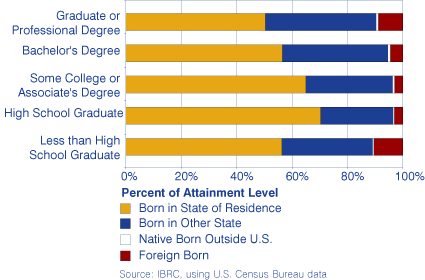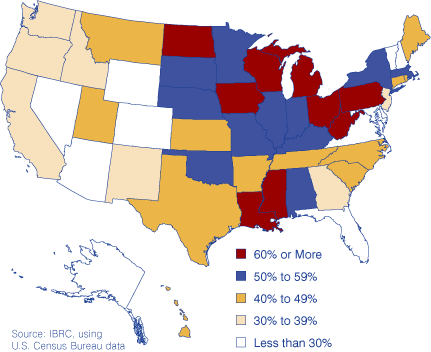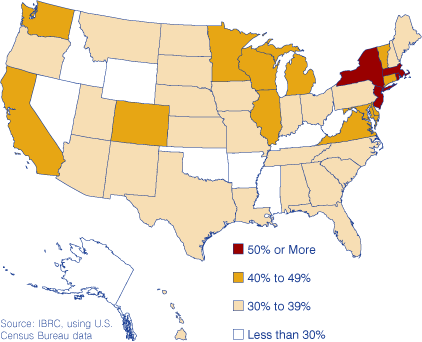Are the Well-Educated Coming to Indiana?
Out of Indiana's 3.9 million adults (age 25 and older), 534,551 have a bachelor's degree, while an additional 306,325 hold a graduate or professional degree. In the third part of our series on education data from the 2005 American Community Survey, we focused our analysis on those with college degrees and where they come from.
To put this segment of the population in perspective, 17 percent of the adult population nationwide have a bachelor's degree and 10 percent have a graduate degree. This compares to Indiana's 14 percent with a bachelor's degree and 8 percent with a graduate degree. Among its neighbors, Indiana trails Illinois, Michigan and Ohio (see Figure 1), though only Illinois exceeds the U.S. averages.
Figure 1: Percent of Adults with Higher Education, 2005

How Many Degree Holders Are Hoosiers by Birth?
About 57 percent of Hoosiers with a bachelor's degree were born in the state; for those with graduate degrees, only half are Indiana natives (see Figure 2). As shown in Figures 3 and 4, the Midwest in general has the highest percentages on these measures (and also on the percentage of native-born in general).
Figure 2: Indiana's Educational Attainment by Place of Birth, 2005
Figure 3: Percent of Those with Bachelor's Degrees Born in State, 2005
Figure 4: Percent of Those with Graduate Degrees Born in State, 2005
Of course, this can be interpreted multiple ways. Are these percentages high because those born in the state like it so much they want to stay (or return) after getting their education? Or is it because non-Hoosiers are unwilling to move to the state because few jobs require their skills, or perhaps because they simply find it unattractive? These data can't answer those questions, but we can use another ACS dataset to reveal the educational attainment of those recently moving to Indiana from other states.
How Educated Are Indiana's Newest Residents?
Between 2004 and 2005, roughly 74,500 people reported moving to Indiana from a different state and 31 percent of them had a bachelor's degree or higher (see Figure 5). At first glance, that doesn't sound too bad, given that only about 21 percent of Indiana's total population falls into that category.
Figure 5: People Who Moved to Indiana from a Different State within the Past Year
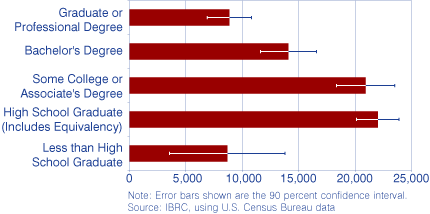
However, considering that the highly educated tend to be more prone to move than others, one finds Indiana ranking fairly low nationwide on this measure. Only 10 states have a lower percentage of its new residents with at least a four-year degree (see Figure 6). Meanwhile, there were five states in the Northeast where more than 50 percent of those moving into them had a bachelor's or graduate degree, led by the District of Columbia at a whopping 72 percent.
Figure 6: Percent of Those Moving to Each State in the Last Year with a Bachelor's Degree or Higher
Jobs Are a Major Attraction
In an increasingly mobile nation, a large percentage of the population seems willing to move in order to capitalize on the best job opportunities. So, if Indiana has a lower number of people with a high level of educational attainment, one could presume that these skills have not traditionally been in great demand (which is a reasonable assumption considering the state's historic reliance on manufacturing). However, if one looks at the latest occupation projections from the Indiana Department of Workforce Development, that appears to be changing.
Between 2004 and 2014, occupations not requiring any post-secondary education are expected to grow 7 percent, while occupations requiring a bachelor's degree or higher are anticipated to increase at a much higher rate of 17 percent. Those occupations requiring just a bachelor's degree have the largest numeric growth, while those requiring a doctorate are projected to increase at the highest rate (see Figure 7). Looking at specific occupations, network systems and data communications analysts are expected to grow at the fastest rate (55 percent, or 1,090 jobs), while elementary school teachers are projected to grow the most numerically (4,200 jobs, or 16 percent).
Figure 7: Indiana's Projected Growth by Level of Educational Attainment, 2004 to 2014
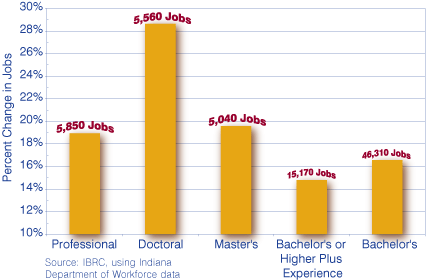
The total number of new positions requiring at least a bachelor's degree is 77,930. Of course, that's just new jobs created during that 10-year span and does not take into account the replacement factor—that is, filling positions left vacant by retirees and others leaving the workforce. When the replacement jobs are factored in, it is projected that Indiana will see 168,080 job openings requiring at least a four-year degree between 2004 and 2014. And the more jobs like that we have, the more likely we'll draw in the educated workforce they require.
Notes
- These occupation projections are available at www.hoosierdata.in.gov and were highlighted in the September issue of InContext. Jon Wright and Bob Ferguson, “Indiana's Occupational Employment Outlook to 2014,” InContext, 7 (9): 1-3.
Rachel Justis, Managing Editor
Indiana
Business Research Center, Kelley School of Business, Indiana University

